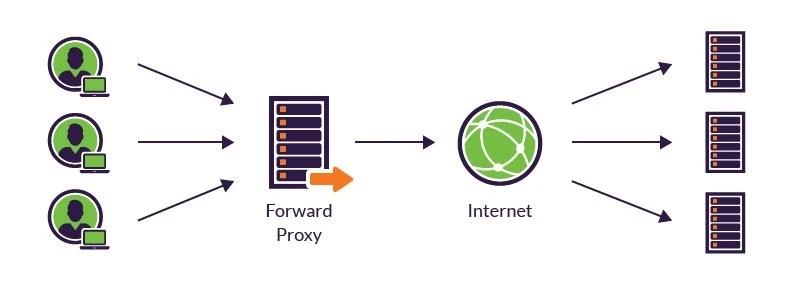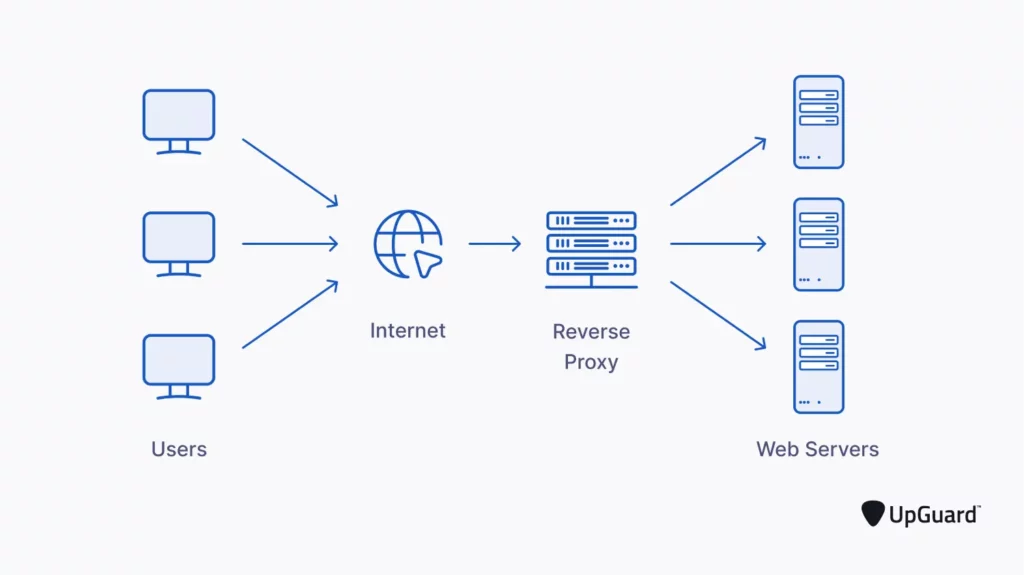
If you’re running an online business, you know how important it is to keep your website quick, secure, and reliable. One way to do that is by using proxy servers.
In this blog, we’ll explore the primary difference between forward and reverse proxies, their applications, benefits.
Whether you’re a website owner, developer, or IT professional, understanding the differences between forward and reverse proxies is essential for optimizing your website’s performance and security.
So, let’s dive in and explore the world of forward and reverse proxies!
What is Proxy?
A proxy server is an intermediary server that acts as a gateway between a client and the internet. It retrieves data from an internet source on behalf of a user and allows several kinds of filtering, such as content filtering, access control, and caching. Proxy servers can be used for various purposes, including improving website performance, enhancing security, and providing anonymity.
Benefits of using Proxy
- There are several benefits of using a proxy server, including enhancing security, regulating internet usage, accessing blocked or restricted websites, and hiding your IP address.
- They function like a firewall between users’ systems and the internet, which can protect against spam and hacker attacks. They can also be used to filter network data, share network connections, and cache data.
- Proxy servers can be used to access services anonymously, which can be useful for privacy reasons. Another advantage of using a proxy server is that it can hide internal clients from an external network, making your network ID anonymous.
- Overall, using a proxy server can provide several benefits for website owners, developers, and IT professionals, including improved security, privacy, and network performance.
There are two main types of proxy servers:
Forward Proxies and Reverse Proxies
Forward Proxy
A forward proxy, also known as a regular proxy, is an internet-facing proxy used to retrieve data from a wide range of sources. It is placed in front of clients and is used to receive and forward client connection requests to a destination web server through a server. When a client sends a connection request to a forward proxy, the proxy retrieves data from the internet on behalf of the client and forwards it back to the client.

The forward proxy is used by a client to access an otherwise firewall-restricted website and can hide the identity and location of the original client by changing their IP address with that of the proxy. Forward proxies act as a security barrier between clients and the internet to protect clients’ computers from any cyberattacks. They are commonly used for web scraping, to collect information from various resources to improve social media campaigns, marketing, pricing, and other business strategies.
Reverse Proxy
A reverse proxy is an application that sits in front of back-end apps and forwards client needs to those applications. It works by intercepting a request from a client, performing action on the request, and sending the request to the appropriate origin server. The origin server’s response then travels back through the reverse proxy, giving the impression to clients that the proxy is the origin server.

Reverse proxies are commonly used to improve website performance, enhance security, and provide anonymity. They can cache frequently requested resources, distribute requests across multiple servers, and protect web servers from cyberattacks. Reverse proxies can also be used to provide load balancing, content filtering, and SSL encryption. To implement a reverse proxy, an organization may create one in-house, or use a reverse proxy as a service, such as through content delivery networks (CDNs). Overall, reverse proxies are an essential component of modern web architecture, and understanding how they work is crucial for optimizing website performance and security.
Key Difference Between Forward Proxy and A Reverse Proxy
The main difference between a forward proxy and a reverse proxy is the direction of the proxy. A forward proxy is used by a client, such as a web browser, to retrieve data from the internet on behalf of the client. It is placed in front of clients and is used to receive and forward client connection requests to a destination web server through a server. On the other hand, a reverse proxy is used by a server to retrieve data from the internet on behalf of the server. It is placed in front of web servers and forwards client requests to those web servers.
In other words, a forward proxy is used by a client to access an otherwise firewall-restricted website, while a reverse proxy is used by a server to protect web servers from cyberattacks and distribute requests across multiple servers. Both types of proxy’s relay requests and responses between clients and destination machines, but they differ in their use cases and direction of the proxy. A reverse proxy ensures that users don’t communicate directly with a backend server.
Understanding the differences between forward and reverse proxies is essential for optimizing website performance and security.
Relation between API Gateway and Proxy
An API gateway and an API proxy provide access to backend services, but they have some differences. An API proxy is generally a simpler proxy that forwards API requests from clients to backend APIs. At the same time, an API gateway provides more features such as mediation, transport security, and creating brand new endpoints from existing services or virtual endpoints that run solely on the gateway without any backend. It provides all the features of an API proxy and much more. Additionally, an API gateway can act as a simple API proxy. It is typically lighter-weight and easier to set up than an API gateway, making it easier for developers new to working with APIs.
To get an API integration services, visit

Conclusion
We believe by reading this blog you understand, that forward and reverse proxies are powerful tools for managing and securing network traffic.
Forward proxies are crucial for privacy and security when browsing the internet, accessing geo-restricted content, web scraping, and much more. Reverse
Proxies are important for websites with many visitors daily because they help avoid overloading and are a perfect fit for caching content, and SSL encryption.
Both forward and reverse proxies perform drastically different functions. They serve decidedly different clients, but they both serve a common mission in enterprise architectures: to facilitate requests for resources between private networks and the public internet. Whether you need to enhance your internal network’s security or access geo-restricted content, forward and reverse proxies are essential tools for managing and securing network traffic.
very interesting info ! .
Thank you a bunch for shharing this with all of us you really recognize what you’re talking about!
Bookmarked.
The very root of your writing whilst sounding reasonable at first, did not settle very well with me after some time. Somewhere within the paragraphs you managed to make me a believer unfortunately only for a very short while. I still have a problem with your jumps in logic and one would do well to fill in those breaks. In the event you actually can accomplish that, I could undoubtedly end up being amazed.
Thanks, I have recently been looking for info about this subject for ages and yours is the best I’ve located so far.